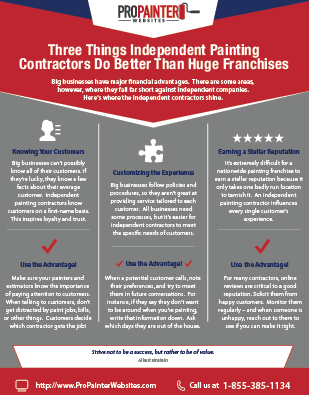Secret Seasonal Considerations For Commercial Exterior Paint: What You Need To Be Educated Concerning
Secret Seasonal Considerations For Commercial Exterior Paint: What You Need To Be Educated Concerning
Blog Article
Authored By- commercial painting contracts
When you're planning an industrial external paint job, seasonal factors can make or break your outcomes. You'll want to think about how temperature level and moisture influence paint application and drying times. Picking paint contractors can ensure your paint sticks properly and lasts longer. Yet which seasons are truly the most effective for this kind of work? Let's discover the key elements that can affect your job's success.
The Influence of Temperature Level on Paint Application
When you're preparing a business external painting project, the temperature level can substantially impact exactly how well the paint sticks and dries.
Preferably, you intend to repaint when temperature levels vary in between 50 ° F and 85 ° F. If it's as well cold, the paint may not treat appropriately, resulting in issues like peeling off or cracking.
On the other side, if it's as well warm, the paint can dry out as well rapidly, stopping proper bond and leading to an uneven surface.
You must likewise think about the moment of day; early morning or late afternoon provides cooler temperatures, which can be extra positive.
Always inspect the maker's recommendations for the certain paint you're using, as they commonly provide advice on the perfect temperature variety for ideal outcomes.
Moisture and Its Impact on Drying Times
Temperature isn't the only environmental variable that influences your industrial exterior paint job; moisture plays a considerable duty also. High moisture degrees can decrease drying out times substantially, affecting the general top quality of your paint job.
When the air is filled with moisture, the paint takes longer to heal, which can cause issues like poor bond and a higher risk of mold development. If you're painting on a particularly damp day, be planned for extended wait times in between coats.
It's important to keep an eye on local climate condition and plan appropriately. Ideally, go for moisture degrees in between 40% and 70% for ideal drying out.
Keeping these factors in mind guarantees your task stays on track and provides a lasting finish.
Best Seasons for Commercial Outside Paint Projects
What's the best season for your industrial outside painting jobs?
popcorn ceiling removal tulsa and early fall are usually your best bets. During these periods, temperatures are moderate, and humidity degrees are usually reduced, developing perfect conditions for paint application and drying.
Avoid summertime's intense heat, which can cause paint to dry too rapidly, resulting in poor attachment and surface. Likewise, wintertime's cold temperature levels can hinder proper drying and healing, risking the longevity of your paint task.
Go for days with temperatures in between 50 ° F and 85 ° F for optimal outcomes. Remember to examine the local weather forecast for rain, as wet conditions can spoil your task.
Preparation around these variables ensures your painting job runs efficiently and lasts much longer.
Conclusion
In conclusion, planning your commercial external painting projects around seasonal considerations can make a substantial difference in the end result. By scheduling work throughout the perfect temperature levels and moisture degrees, you'll make certain much better bond and drying times. Remember to watch on local weather forecasts and choose the right time of year-- springtime and early fall are your best choices. Taking these actions will certainly aid you accomplish a durable and specialist coating that lasts.
